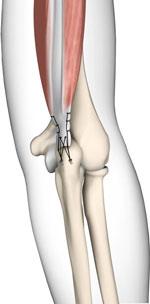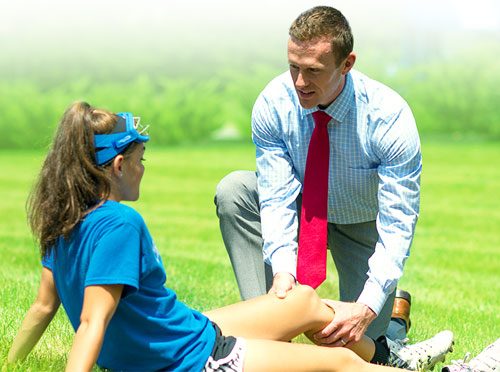Dr. Rice has joined Beacon Orthopedics and Sports Medicine
Congratulations Dr. Rice: 2025 Cincinnati Magazine Top Doctor
Triceps Tendon Repair

Triceps repair is a surgical procedure that involves the repair of a ruptured (torn) triceps tendon. A tendon is a tough band of fibrous tissue which connects muscle to bone, and works together with muscles in moving your arms, fingers, legs, and toes. The triceps tendons connect the triceps muscles to the shoulder blade and elbow in your arm. Rupture of the triceps tendon is a rare injury which occurs as a result of the detachment of the triceps tendon from the attached bone. These tendons can rupture with lifting heavy weights, during contact sports or after a fall on an outstretched arm.
Indications
Triceps repair is indicated for partial or complete rupture of the triceps tendons after trauma or injury. It is also indicated for repairing acute (injuries occurring within four weeks) or chronic (injuries occurring after four weeks) triceps tendon injuries. Distal triceps tendon rupture occurs due to detachment of the triceps tendon connecting the triceps muscles to the elbow. These injuries require immediate medical attention and surgical repair to restore the activity of the triceps muscles.
Triceps repair is indicated for partial or complete rupture of the triceps tendons after trauma or injury. It is also indicated for repairing acute (injuries occurring within four weeks) or chronic (injuries occurring after four weeks) triceps tendon injuries. Distal triceps tendon rupture occurs due to detachment of the triceps tendon connecting the triceps muscles to the elbow. These injuries require immediate medical attention and surgical repair to restore the activity of the triceps muscles.
Pre-procedural preparation
Your surgeon may order blood tests and other essential tests a few days before the surgery. Magnetic resonance imaging (MRI) may be suggested to examine parts of your arm, muscles and blood vessels. X-rays of your shoulder, elbow and arms may be ordered. Your blood pressure, breathing rate, temperature and heart rate will also be recorded. Your shoulder, arm, forearm, and elbow will be cleaned with soap and water and will be covered with sheets before the procedure.
Surgical Procedure
Medications through an intravenous line will be administered to help you relax. The procedure will be performed under general or regional anesthesia to keep you comfortable during the surgery.
Your surgeon will make an incision behind the elbow and drill holes into the end of the ulna (bone in the forearm). The ends of the torn tendons will then be inserted through the holes and stitched. Your surgeon may also use screws and buttons to attach the tendon to the bone. For chronic tendon injuries, a tendon or a hard tissue from another part of the body may be used to lengthen the existing short tendon. After the tendon is attached to the bone, it is sutured and the incisions are closed with surgical tapes or bandages.
Post-operative care
After the procedure, a cast or splint is placed on the elbow to prevent movement and protect the tendon while it heals. After 6 to 8 weeks of surgery, your physical therapist will teach you exercises to be performed at home for improving strength and range of motion in your arm. Contact your doctor if you have a fever >101° or swelling, redness, or drainage from the incision.
Risks and complications
As with any surgical procedure, triceps repair involves certain potential risks and complications. They include:
- Bleeding and infection at the surgical site
- Damage to the other parts of the arm, such as muscles, bones, nerves or blood vessels
- Restricted movement of the arm
- Difficulty in resuming usual activities or sports


